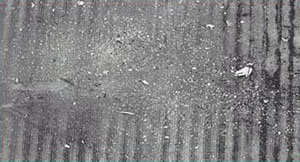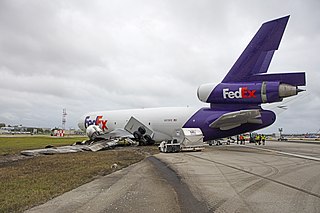Empire Airlines is a passenger and cargo airline based in Hayden, Idaho, near Coeur d'Alene. It operates over 120 scheduled cargo flights a day in 18 US states and Canada. Empire also started passenger service within Hawaii, under the name "Ohana by Hawaiian", which was run from 2014-2021. Its main base is Coeur d'Alene Airport with a hub at Spokane International Airport. The company slogan is We Can Do That.

United Airlines Flight 585 was a scheduled passenger flight on March 3, 1991, from Denver to Colorado Springs, Colorado, carrying 20 passengers and 5 crew members on board. The plane experienced a rudder hardover while on final approach to runway 35 at Colorado Springs Municipal Airport, causing the plane to roll over and enter an uncontrolled dive. All 25 people on board were killed.

American Eagle Flight 4184, officially operating as Simmons Airlines Flight 4184, was a scheduled domestic passenger flight from Indianapolis, Indiana to Chicago, Illinois, United States. On October 31, 1994, the ATR 72 performing this route flew into severe icing conditions, lost control and crashed into a field. All 68 people aboard were killed in the high-speed impact.

Comair Flight 3272 was a Comair flight from Cincinnati to Detroit on Thursday, January 9, 1997. While on approach for landing, the Embraer EMB 120 Brasilia aircraft crashed nose-down 18 miles (29 km) southwest of Detroit Metropolitan Wayne County Airport at 15:54 EST. All 29 aboard, 26 passengers and three crew members, were killed.

Comair Flight 5191 was a scheduled United States domestic passenger flight from Lexington, Kentucky, to Atlanta, Georgia. On the morning of August 27, 2006, at around 06:07 EDT, the Bombardier Canadair Regional Jet 100ER crashed while attempting to take off from Blue Grass Airport in Fayette County, Kentucky, 4 miles west of the central business district of the city of Lexington.

FedEx Express Flight 647 was a flight between Metropolitan Oakland International Airport (OAK), Oakland, California and Memphis International Airport (MEM), Memphis, Tennessee that crashed during landing on December 18, 2003.

Mohawk Airlines Flight 405, a Fairchild Hiller FH-227 twin-engine turboprop airliner registered N7818M, was a domestic scheduled passenger flight operated by Mohawk Airlines that crashed into a house within the city limits of Albany, New York, on March 3, 1972, on final approach to Albany County Airport, New York, killing 17 people. The intended destination airport lies in the suburban Town of Colonie, about 4 miles north of the crash site.

Colgan Air Flight 3407 was a scheduled passenger flight from Newark, New Jersey, US to Buffalo, New York, US on February 12, 2009. Colgan Air staffed and maintained the aircraft used on the flight that was scheduled, marketed and sold by Continental Airlines under its Continental Connection brand. The aircraft, a Bombardier Q400, entered an aerodynamic stall from which it did not recover and crashed into a house at 6038 Long Street in Clarence Center, New York at 10:17 pm EST, killing all 49 passengers and crew on board, as well as one person inside the house.

Northwest Airlink Flight 5719 was a flight from Minneapolis-Saint Paul International Airport to International Falls Airport in International Falls, Minnesota with a scheduled intermediate stop at Chisholm-Hibbing Airport in Hibbing, Minnesota. On December 1, 1993, the Jetstream 31, operated by Express Airlines I as Northwest Airlink, collided with a group of trees in a forest during final approach to Hibbing, and crashed into two ridges northwest of the airport, killing all sixteen passengers and the two pilots on board.

Southwest Airlines Flight 345 was a scheduled flight from Nashville International Airport, Tennessee, to New York City's LaGuardia Airport. On July 22, 2013, the Boeing 737 operating the route suffered a front landing gear collapse while landing at LaGuardia Airport, injuring 9 people on board. The aircraft, which was worth an estimated $15.5 million at the time, was written off and scrapped as a result of the accident.

Trans-Colorado Airlines Flight 2286 was a scheduled domestic passenger flight from Denver, Colorado, to Durango, Colorado, operated for Continental Express by Trans-Colorado Airlines. On January 19, 1988, Flight 2286 crashed onto terrain near Bayfield, Colorado, while on approach to Durango-La Plata County Airport. Out of the seventeen people on board, nine were killed, including both crew members.

On October 28, 2016, FedEx Express Flight 910, a McDonnell Douglas MD-10-10F flying from Memphis International Airport to Fort Lauderdale–Hollywood International Airport was involved in a runway skid after a landing gear collapse, which resulted in a fire completely destroying the left engine and wing. Two crew members, the only people on board, were unharmed.

Japan Air Lines Cargo Flight 1045 was a charter flight on January 13, 1977, from Grant County, Washington, United States, to Tokyo, Japan, with a stopover in Anchorage, Alaska, United States. The flight crashed during the initial climb phase, shortly after takeoff from Anchorage, in part because the flight captain, Hugh L. Marsh, was intoxicated as shown by a blood alcohol level of 0.29; the co-pilot and the other crew were not impaired. All of those on board, including three flight crew members and two cattle handlers, were killed in the crash.

East Coast Jets Flight 81 was a business jet flight operated by East Coast Jets that crashed on July 31, 2008 while attempting a go-around at Owatonna Degner Regional Airport near Owatonna, Minnesota, killing all eight passengers and crew on board. The flight originated in Atlantic City International Airport, and was scheduled to land in Owatonna. The crew made a go-around attempt after the aircraft touched down, but it overran the runway, hit the Instrument Landing System localizer antenna at an altitude of approximately 5 ft (1.5 m), stalled and crashed, with the main wreckage coming to rest 2,400 ft (730 m) from the runway end.

West Wind Aviation Flight 282 was a domestic passenger flight from Fond-du-Lac Airport to Stony Rapids Airport, Canada. The aircraft was an ATR 42-320 registered C-GWEA. On 13 December 2017, shortly after taking off from Fond-du-Lac, the ATR-42 lost altitude and hit the ground. All 25 passengers and crew initially survived the crash, but one passenger later died of his injuries in hospital. Investigation on the cause of the crash determined that it was caused by ice contamination on the aircraft.

Scandinavian Airlines System Flight 901, was a scheduled international flight operated by the Scandinavian Airlines System, that overran the runway at its destination at John F. Kennedy International Airport on February 28, 1984. The flight, using a McDonnell Douglas DC-10, originated at Stockholm Arlanda Airport, Sweden, before a stopover at Oslo Airport, Gardermoen, Norway. All 177 passengers and crew members on board survived, although 12 were injured. The runway overshoot was due to the crew's failure to monitor their airspeed and overreliance on the aircraft's autothrottle.

Pan Am Flight 799 was an international cargo flight from Los Angeles International Airport to Cam Ranh Airport in South Vietnam that crashed on December 26, 1968, near Anchorage, Alaska. The aircraft involved was a Boeing 707-321C aircraft operated by Pan American World Airways. All three crew members died in the crash.

TransAsia Airways Flight 791 was a regular cargo flight between Chiang Kai Shek International Airport and Macau International Airport. At 01:52 am local time on 21 December 2002, the ATR 72 operating the flight crashed into the sea 17 kilometres southwest of Magong, Penghu, Taiwan. The two crew members on board were killed.

FedEx Express Flight 1478 was a scheduled domestic cargo flight from Memphis International Airport to Tallahassee International Airport. On July 26, 2002, the Boeing 727-232F aircraft flying this route crashed during landing at Tallahassee. All three flight crew members survived the accident with serious injuries, but the aircraft was destroyed.

Ryan International Airlines Flight 590 was a cargo flight carrying mail for the United States Postal Service from Greater Buffalo International Airport (BUF) in Buffalo, New York, to Indianapolis International Airport (IND) in Indiana, with a stopover at Cleveland Hopkins International Airport (CLE) in Cleveland, Ohio. On February 17, 1991, the McDonnell Douglas DC-9-15RC operating the flight crashed on takeoff from Cleveland during icing conditions. Both pilots, the aircraft's only occupants, were killed. The National Transportation Safety Board (NTSB) determined that the causes of the crash were the flight crew failing to deice their aircraft, and the inexperience of the Federal Aviation Administration (FAA), McDonnell Douglas, and Ryan International Airlines with icing condition on DC-9-10 aircraft.






















